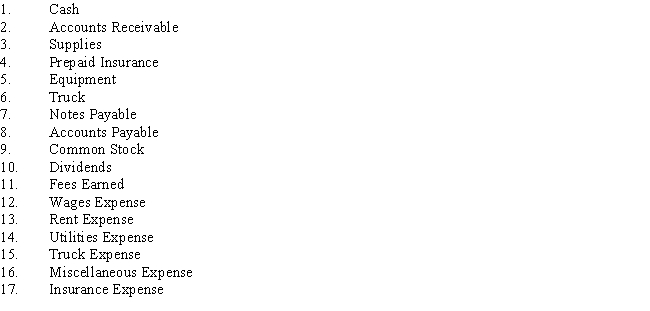A) No entry until the cash is received
B) Fees Earned, debit; Accounts Receivable, credit
C) Cash, debit; Fees Earned, credit
D) Accounts Receivable, debit; Fees Earned, credit
F) A) and C)
Correct Answer

verified
Correct Answer
verified
True/False
The order of the flow of accounting data is (1) record in the ledger, (2) record in the journal, (3) prepare the financial statements.
B) False
Correct Answer

verified
Correct Answer
verified
Essay
On January 1, Merry Walker and other stockholders established a catering service. Listed below are accounts to use for transactions (a) through (e), each identified by a number. Following this list are the transactions that occurred in Walker's first month of operation. You are to indicate for each transaction the accounts that should be debited and credited by placing the account number(s) in the appropriate box. 

Correct Answer

verified
Correct Answer
verified
Matching
Match each of the following accounts with its proper account group from groups listed below.
Correct Answer
True/False
An account in its simplest form has three parts to it: a title, an increase side, and a decrease side.
B) False
Correct Answer

verified
Correct Answer
verified
Multiple Choice
The accounts in the ledger of Nilles Consulting Co. are listed below. All accounts have normal balances. 
Prepare a trial balance. The total of the credits is
Prepare a trial balance. The total of the credits is
A) $15,800
B) $21,300
C) $22,600
D) $26,200
F) A) and C)
Correct Answer

verified
Correct Answer
verified
Essay
For each of the following errors, considered individually, indicate whether the error would cause the trial balance totals to be unequal. If the error would cause the trial balance totals to be unequal, indicate whether the debit or credit total is higher and by how much.

Correct Answer

verified
Correct Answer
verified
Essay
On September 1, Erika Company purchased land for $47,500 cash. Provide the journal entry for this transaction.
Correct Answer

verified
Correct Answer
verified
Multiple Choice
In which order are the accounts listed in the chart of accounts?
A) assets, expenses, liabilities, stockholders' equity, revenues
B) stockholders' equity, assets, liabilities, revenues, expenses
C) assets, liabilities, stockholders' equity, revenues, expenses
D) assets, liabilities, revenues, expenses, stockholders' equity
F) A) and C)
Correct Answer

verified
Correct Answer
verified
Multiple Choice
Which of the following is not true with a double-entry accounting system?
A) The accounting equation remains in balance.
B) The sum of all debits is always equal to the sum of all credits in each journal entry.
C) Each business transaction will have two debits.
D) Every transaction affects at least two accounts.
F) A) and D)
Correct Answer

verified
Correct Answer
verified
Multiple Choice
Which of the following entries records the payment of an account payable?
A) debit Cash; credit Accounts Payable
B) debit Accounts Receivable; credit Cash
C) debit Cash; credit Supplies Expense
D) debit Accounts Payable; credit Cash
F) None of the above
Correct Answer

verified
Correct Answer
verified
Multiple Choice
The debit side of an account
A) depends on whether the account is an asset, liability, or stockholders' equity
B) can be either side of the account depending on how the accountant set up the system
C) is the right side of the account
D) is the left side of the account
F) C) and D)
Correct Answer

verified
Correct Answer
verified
True/False
A chart of accounts is a listing of accounts that make up the journal.
B) False
Correct Answer

verified
Correct Answer
verified
Multiple Choice
Which of the following transactions increases stockholders' equity?
A) Supplies are purchased on account.
B) Services are provided on account.
C) Cash is received from customers on account.
D) Utility bill will be paid next month.
F) A) and D)
Correct Answer

verified
Correct Answer
verified
Multiple Choice
Accounts are classified in the ledger
A) chronologically
B) alphabetically
C) in accordance with their appearance in the financial statements
D) with the accounts used most often listed first
F) None of the above
Correct Answer

verified
Correct Answer
verified
Multiple Choice
Which are the parts of the T account?
A) title, date, total
B) date, debit side, credit side
C) title, debit side, credit side
D) title, debit side, total
F) B) and D)
Correct Answer

verified
Correct Answer
verified
Essay
Use the information below to answer the question that follows.
All nine transactions for Ralston Sports Co. for September, the first month of operations, are recorded in the following T accounts:





-Prepare an unadjusted trial balance, listing the accounts in their proper order.
-Prepare an unadjusted trial balance, listing the accounts in their proper order.
Correct Answer

verified
Correct Answer
verified
Multiple Choice
The purchase of supplies on account was recorded and posted as a debit to Supplies for $500 and a credit to Accounts Receivable for $500. The correcting entry would include a:
A) credit to Accounts Receivable for $500
B) credit to Accounts Receivable for $1,000
C) credit to Accounts Payable for $500
D) credit to Accounts Payable for $1,000
F) None of the above
Correct Answer

verified
Correct Answer
verified
Multiple Choice
In accordance with the debit and credit rules, which of the following is true?
A) Debits increase assets.
B) Credits increase assets.
C) Debits increase both assets and common stock.
D) Credits increase both assets and liabilities.
F) A) and B)
Correct Answer

verified
Correct Answer
verified
True/False
Even when a trial balance is in balance, there may be errors in the individual accounts.
B) False
Correct Answer

verified
Correct Answer
verified
Showing 121 - 140 of 219
Related Exams